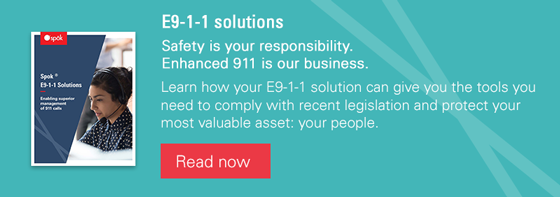Blog
How to strengthen your emergency call system to comply with Kari’s Law and the Ray Baum’s Act
The Federal Communications Commission (FCC) recently adopted two rules that will impact every U.S. business that uses a multi-line telephone system (MLTS)—Kari’s Law and Section 506 of the Ray Baum’s Act.
Is your organization ready to comply with these two federal laws? In this post, we’ll outline each law, how your organization can comply, and how Spok can be your partner to help meet the new guidelines.

Kari’s Law background and compliance details
The need for Kari’s Law was born from tragic circumstances. According to the FCC, the law is named in honor of Kari Hunt, who was killed by her estranged husband in a hotel room. Hunt’s daughter attempted to call 911 four times from the hotel room, but the call never went through because the phone system required guests to dial “9” to initiate an outbound call, even before dialing 911.
Kari’s Law, signed by Congress in 2018, requires MLTS to support direct dialing of 911. That is, an MLTS must initiate a 911 phone call without requiring an initial digit, like 9 or 1, first. In addition, to help speed response times when first responders arrive the MLTS system must notify a central location, like the front desk or security office, where someone is likely to be alerted of the 911 call.
The notifications must include at least:
- An alert that the MLTS has made a 911 call
- A callback number
- Information about the caller’s location (for example, a hotel room number)
The FCC does note, however, there may be cases where it’s not possible to provide a callback number or location information.
These two parts of Kari’s Law are known as the direct dialing and notification requirements.
Ray Baum’s Act background and compliance details
Section 506 of the Ray Baum’s act requires all 911 calls, including those from MLTS, to include the “dispatchable location” to help first responders quickly locate the caller. According to the FCC, “Dispatchable location information includes the street address of the caller and additional information, such as room or floor number, necessary to adequately locate the caller.”
Essentially, the purpose of the Ray Baum’s act is to improve emergency responses by better sharing the precise location of someone calling 911, including when calling from an MLTS.
When does your organization need to comply with Kari’s Law and Section 506 of the Ray Baum’s Act?
The requirements of Kari’s Law took effect on Feb. 16, 2020. Though the FCC will not invoke consequences for systems installed before Feb. 16, 2020, any updates, alterations, or new software must meet direct dialing and notification requirements. To comply with Kari’s Law, your organization must ensure you’re meeting the direct dialing and notification requirements outlined above.
Depending on the type of MLTS device (fixed or non-fixed, on-premise or off-premise), the Ray Baum’s act compliance deadlines range from Jan. 6, 2021 to Jan. 6, 2022. To comply with Section 506 of the Ray Baum’s act, your organization must deliver the dispatchable location to the public safety answering point (PSAP) with any 911 call, including those from MLTS.
See the Ray Baum’s Act and Kari’s Law infographic here >>
How can your organization meet the requirements of Kari’s Law and Section 506 of the Ray Baum’s Act?
Spok is a partner to organizations that require the highest standards in systems and processes to achieve secure communications with speed, accuracy, and efficiency. We provide emergency notification solutions for a wide variety of businesses—from federal, state, and local agencies to hotels, casinos, campuses, national organizations, single site businesses, and healthcare organizations.
We’ve helped many facilities move from traditional phone systems to more sophisticated communications that ensure accurate notification of critical information on the right communications device to assist in an emergency.
Our emergency notification solutions can help your organization meet and exceed the requirements of Kari’s Law and Section 506 of the Ray Baum’s act. Please connect with us to learn more.




